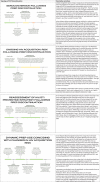PrEP initiation and discontinuation among transgender women in the United States: a longitudinal, mixed methods cohort study
- PMID: 38123897
- PMCID: PMC10733152
- DOI: 10.1002/jia2.26199
PrEP initiation and discontinuation among transgender women in the United States: a longitudinal, mixed methods cohort study
Abstract
Introduction: Transgender women in the United States experience high HIV incidence and suboptimal Pre-exposure prophylaxis (PrEP) engagement. We sought to estimate PrEP initiation and discontinuation rates and characterize PrEP discontinuation experiences among a prospective cohort of transgender women.
Methods: Using a sequential, explanatory, mixed-methods design, 1312 transgender women at risk for HIV acquisition were enrolled from March 2018 to August 2020 and followed through July 2022 (median follow-up 24 months; interquartile range 15-36). Cox regression models assessed predictors of initiation and discontinuation. In-depth interviews were conducted among 18 participants, including life history calendars to explore key events and experiences surrounding discontinuations. Qualitative and quantitative data were integrated to generate typologies of discontinuation, inform meta-inferences and facilitate the interpretation of findings.
Results: 21.8% (n = 286) of participants reported taking PrEP at one or more study visits while under observation. We observed 139 PrEP initiations over 2127 person-years (6.5 initiations/100 person-years, 95% CI: 5.5-7.7). Predictors of initiation included identifying as Black and PrEP indication. The rate of initiation among those who were PrEP-indicated was 9.6 initiations/100 person-years (132/1372 person-years; 95% CI: 8.1-11.4). We observed 138 PrEP discontinuations over 368 person-years (37.5 discontinuations/100 person-years, 95% CI: 31.7-44.3). Predictors of discontinuation included high school education or less and initiating PrEP for the first time while under observation. Four discontinuation typologies emerged: (1) seroconversion following discontinuation; (2) ongoing HIV acquisition risk following discontinuation; (3) reassessment of HIV/STI prevention strategy following discontinuation; and (4) dynamic PrEP use coinciding with changes in HIV acquisition risk.
Conclusions: PrEP initiation rates were low and discontinuation rates were high. Complex motivations to stop using PrEP did not consistently correspond with HIV acquisition risk reduction. Evidence-based interventions to increase PrEP persistence among transgender women with ongoing acquisition risk and provide HIV prevention support for those who discontinue PrEP are necessary to reduce HIV incidence in this population.
Keywords: PrEP discontinuation; PrEP initiation; discontinuation typologies; pre-exposure prophylaxis; prevention-effective adherence; transgender women.
© 2023 The Authors. Journal of the International AIDS Society published by John Wiley & Sons Ltd on behalf of International AIDS Society.
Conflict of interest statement
The authors declare no competing interests.
Figures


Similar articles
-
Sexual behaviour and incidence of sexually transmitted infections among men who have sex with men (MSM) using daily and event-driven pre-exposure prophylaxis (PrEP): Four-year follow-up of the Amsterdam PrEP (AMPrEP) demonstration project cohort.PLoS Med. 2024 May 8;21(5):e1004328. doi: 10.1371/journal.pmed.1004328. eCollection 2024 May. PLoS Med. 2024. PMID: 38718068 Free PMC article.
-
Population-Level Effectiveness of HIV Pre-exposure Prophylaxis Among MSM and Transgender Persons With Bacterial Sexually Transmitted Infections.J Acquir Immune Defic Syndr. 2021 Jun 1;87(2):769-775. doi: 10.1097/QAI.0000000000002646. J Acquir Immune Defic Syndr. 2021. PMID: 33538527 Free PMC article.
-
Factors associated with long-term HIV pre-exposure prophylaxis engagement and adherence among transgender women in Brazil, Mexico and Peru: results from the ImPrEP study.J Int AIDS Soc. 2022 Oct;25 Suppl 5(Suppl 5):e25974. doi: 10.1002/jia2.25974. J Int AIDS Soc. 2022. PMID: 36225148 Free PMC article.
-
Prevention-effective adherence trajectories among transgender women indicated for PrEP in the United States: a prospective cohort study.Ann Epidemiol. 2022 Jun;70:23-31. doi: 10.1016/j.annepidem.2022.03.016. Epub 2022 Apr 6. Ann Epidemiol. 2022. PMID: 35398255 Free PMC article.
-
Same-day initiation of oral pre-exposure prophylaxis among gay, bisexual, and other cisgender men who have sex with men and transgender women in Brazil, Mexico, and Peru (ImPrEP): a prospective, single-arm, open-label, multicentre implementation study.Lancet HIV. 2023 Feb;10(2):e84-e96. doi: 10.1016/S2352-3018(22)00331-9. Epub 2022 Dec 21. Lancet HIV. 2023. PMID: 36565708 Free PMC article.
Cited by
-
Infections Following Gender-Affirming Vaginoplasty: A Single-Center Experience.Open Forum Infect Dis. 2024 Sep 11;11(10):ofae526. doi: 10.1093/ofid/ofae526. eCollection 2024 Oct. Open Forum Infect Dis. 2024. PMID: 39411218 Free PMC article.
References
-
- Baral SD, Poteat T, Stromdahl S, Wirtz AL, Guadamuz TE, Beyrer C. Worldwide burden of HIV in transgender women: a systematic review and meta‐analysis. Lancet Infect Dis. 2013;13(3):214–222. - PubMed
Publication types
MeSH terms
Substances
Grants and funding
LinkOut - more resources
Full Text Sources
Medical
Miscellaneous

